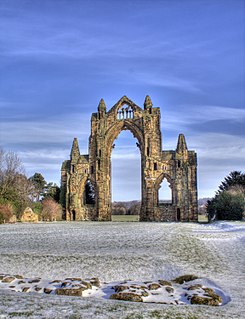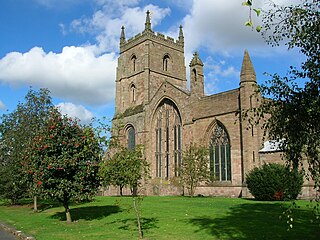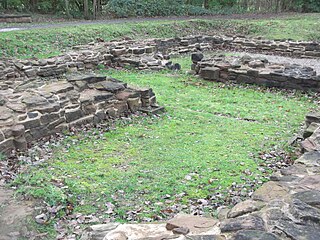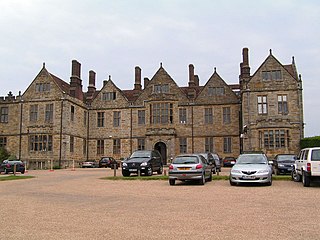
Gisborough Priory is a ruined Augustinian priory in Guisborough in the current borough of Redcar and Cleveland, historic North Riding of Yorkshire, England. It was founded in 1119 as the Priory of St Mary by the Norman feudal magnate Robert de Brus, also an ancestor of the Scottish king, Robert the Bruce. It became one of the richest monastic foundations in England with grants from the crown and bequests from de Brus, other nobles and gentry and local people of more modest means. Much of the Romanesque Norman priory was destroyed in a fire in 1289. It was rebuilt in the Gothic style on a grander scale over the following century. Its remains are regarded as among the finest surviving examples of early Gothic architecture in England.
Margaret de Clare, Countess of Gloucester, Countess of Cornwall was an English noblewoman, heiress, and the second-eldest of the three daughters of Gilbert de Clare, 6th Earl of Hertford and his wife Joan of Acre, making her a granddaughter of King Edward I of England. Her two husbands were Piers Gaveston and Hugh de Audley, 1st Earl of Gloucester.

Baron Audley is a title in the Peerage of England first created in 1313, by writ to the Parliament of England, for Sir Nicholas Audley of Heighley Castle, a member of the Anglo-Norman Audley family of Staffordshire.

Leominster is a market and minster town in Herefordshire, England, at the confluence of the River Lugg and its tributary the River Kenwater 12 miles (19 km) north of Hereford and 7 miles south of Ludlow in Shropshire. With a population of 11,700, Leominster is the largest of the five towns in the county.

Clare is a market town on the north bank of the River Stour in Suffolk, England. Clare is 14 miles (23 km) from Bury St Edmunds and 9 miles (14 km) from Sudbury. It lies in the "South and Heart of Suffolk". As a cloth town, it is one of Suffolk's "threads". Clare won Village of the Year in 2010 and Anglia in Bloom award for Best Large Village 2011 for its floral displays in 2011. In March 2015, The Sunday Times and Zoopla placed Clare amongst the top 50 UK rural locations, having "period properties and rich history without the chocolate-box perfection – and the coach trips".

Ralph de Stafford, 1st Earl of Stafford, 2nd Baron Stafford,, KG, of Stafford Castle and Madeley Castle in Staffordshire, was an English nobleman and notable soldier during the Hundred Years War against France.
Richard fitz Gilbert was a Norman lord who participated in the Norman conquest of England in 1066, and was styled "de Bienfaite", "de Clare", and of "Tonbridge" from his holdings.
Richard fitz Gilbert de Clare 3rd Lord of Clare, was an Anglo-Norman nobleman. A marcher lord in Wales, he was also the founder of Tonbridge Priory in Kent.

Newport Castle is a ruined castle in Newport, Wales. It was built in the 14th century, probably by Hugh de Audley, 1st Earl of Gloucester or his son-in-law, Ralph, Earl of Stafford, with the purpose of managing the crossing of the River Usk. The castle was used as administrative offices for the collection of rent and dues from local tenants, and was also a residence and a garrison. In 1402 it was sacked by Owain Glyndŵr. It was in disrepair by 1522, and was taken by Oliver Cromwell's forces during the Civil War. Its use declined further in later centuries. It has been a Grade II* Listed building since 1951.

Hugh de Audley, 1st Earl of Gloucester, 1st Baron Audley of Stratton Audley in Oxfordshire, and of Gratton in Staffordshire, served as Sheriff of Rutland and was the English Ambassador to France in 1341. He was buried in Tonbridge Priory.

Piddington is a village and civil parish about 4.5 miles (7 km) southeast of Bicester in Oxfordshire, England. It lies close to the border with Buckinghamshire. Its toponym has been attributed to the Old English Pyda's tun. The 2011 Census recorded the parish's population as 370.

King's Mead Priory was a Benedictine Priory situated west of Derby, in the area currently known as Nun's Street, or Nun's Green. It was the only Benedictine Nunnery in Derbyshire.

Farewell Priory was a Benedictine nunnery near Lichfield in Staffordshire, England. Although it received considerable episcopal support, it was always small and poor. It was dissolved in 1527 as a by-product of Cardinal Wolsey's scheme to establish a college within Oxford University.

Priory of St. Thomas near Stafford was an Augustinian religious house near Stafford, Staffordshire, England. Founded sometime in approximately 1174, it was a surrendered to the Crown in 1538, during the Dissolution of the Monasteries.

Sandwell Priory was a small medieval Benedictine monastery, near West Bromwich, then part of Staffordshire, England. It was founded in the late 12th century by a local landowner and was only modestly endowed. It had a fairly turbulent history and suffered considerably from mismanagement. It was dissolved in 1525 at the behest of Cardinal Wolsey – more than a decade before the main Dissolution of the Monasteries under Henry VIII
Hulton Abbey is a scheduled monument in the United Kingdom, a former monastery located in what is now Abbey Hulton, a suburb of Stoke-on-Trent. A daughter house of the Cistercian Combermere Abbey, the abbey was founded by Henry de Audley in the early 13th century. Throughout its life, the abbey was relatively small and poor, with one of the lowest incomes of all Staffordshire religious houses. The abbey was dissolved by Henry VIII in 1538, with its land and assets being sold.

Somerhill House is a Grade I listed Jacobean mansion situated near Tonbridge, Kent, United Kingdom. It was built for The 4th Earl of Clanricarde in 1611–13. The estate was sequestrated by Parliament in 1645, and restored to its rightful owner in 1660. The building had become derelict by the mid-eighteenth century but was later restored. Somerhill was painted by Turner in 1811. It was bought by a member of the Goldsmid family in 1849 and greatly extended between 1879 and 1897, making it the second largest house in Kent, after Knole House, Sevenoaks.

St Lawrence's Church is an Anglican parish church at Mereworth, Kent, United Kingdom. It is in the deanery of West Malling, the Diocese of Rochester and Province of Canterbury. The church was built in the mid-1740s by John Fane, the 7th Earl of Westmorland, following his removal of the village's 12th century place of worship to allow for the enlargement of Mereworth Castle.
Stoke-by-Clare Priory was a Benedictine monastery in Stoke-by-Clare, in Suffolk, an alien priory, dependent on Bec Abbey, in Normandy. Reinstituted in 1124, the Priory was suppressed in 1415.















